Adam Booth | June 16, 2016
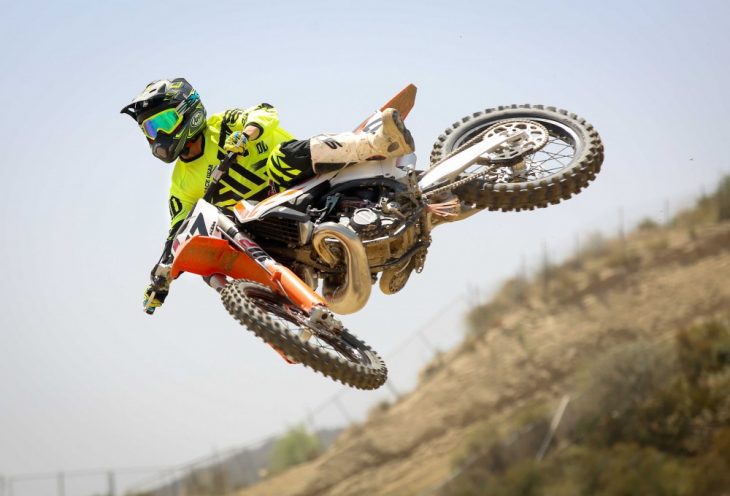 The 2017 KTM 250 SX is a completely new motorcycle
The 2017 KTM 250 SX is a completely new motorcycle
The 2017 KTM 250 SX is a completely new motorcycle
Story and Photography by Adam Booth
The 2017 KTM 250 SX two-stroke is all new. Forget what you knew about the 250 SX prior to now; it bears no resemblance, minus the fact it was a two-stroke KTM. For 2017 KTM focused on weight reduction and centralization of mass, two elements every manufacturer strives to improve year after year, KTM more so than others. Every two-stroke fanatic (we fall into that category) should be jumping for joy that two-strokes are still alive and kicking butt.
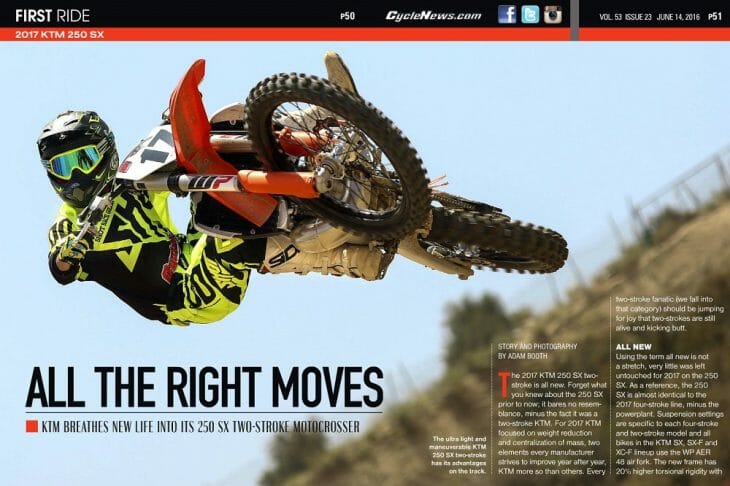
You can read the original magazine story by clicking HERE
All New
Using the term all new is not a stretch, very little was left untouched for 2017 on the 250 SX. As a reference, the 250 SX is almost identical to the 2017 four-stroke line, minus the powerplant. Suspension settings are specific to each four-stroke and two-stroke model and all bikes in the KTM SX, SX-F and XC-F lineup use the WP AER 48 air fork. The new frame has 20% higher torsional rigidity with 30-percent less longitudinal stiffness in the never-ending quest to better absorb the energy from rear-wheel loads. The steering head is steeper by four degrees and the upper engine mounts are now laterally attached.
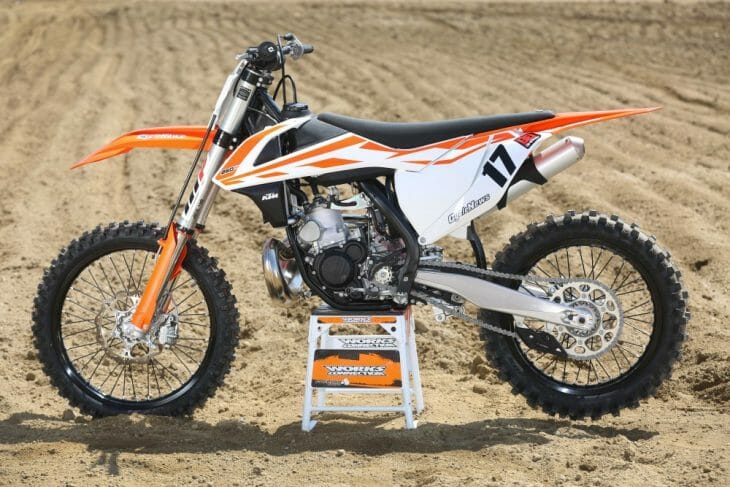 The KTM 250 SX is all new for 2017—and we mean all new.
The KTM 250 SX is all new for 2017—and we mean all new.
The overall wheelbase is 10mm shorter than 2016. Some of the 2017 weight savings comes from a smaller and lighter subframe. As we mentioned, the WP AER 48 air fork is now standard and saves an impressive 3.6 pounds in comparison to last year’s 4CS fork. Standard air pressure is 149 psi (10.2 bar). The new air box is home to the new air filter and filter-support system. It is even easier to change an air filter in 2017. Since the KTM 250 SX shares the same ergos as the four-strokes, the seat height is now 10mm lower through the middle and 20mm lower at the back of the seat, creating a lower center of gravity. The new radiator design increases cooling and overall strength.
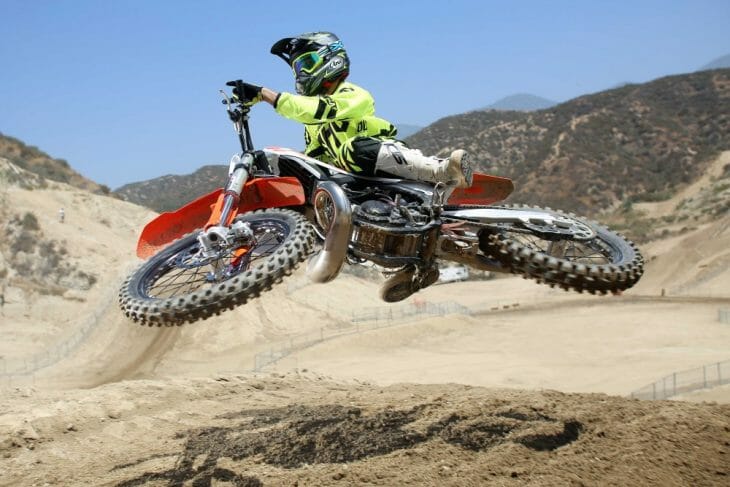 That two-stroke vibe has been significantly reduced thanks to the new addition of a counter-balancer.
That two-stroke vibe has been significantly reduced thanks to the new addition of a counter-balancer.
The 250/300 two-stroke engine is the most produced engine at the KTM factory. It finds a home in the KTM 250 SX, KTM 250/300 XC, and KTM 250/300 XCW. It is also in the Husqvarna TC 250, TE 250/300 and TX 250/300. For 2017 the trusted powerplant is completely new with the clutch and crankshaft closer to the center of gravity. The cylinder has new transfer and exhaust ports, a reworked exhaust valve system and an optimized water-jacket. A big addition to the two-stroke engine is a counter-balancer, which KTM claims reduces vibration by more than 50-percent. Feeding the new engine is a Mikuni TX 38 carburetor. KTM two-strokes haven’t run Mikuni carbs since 1988.
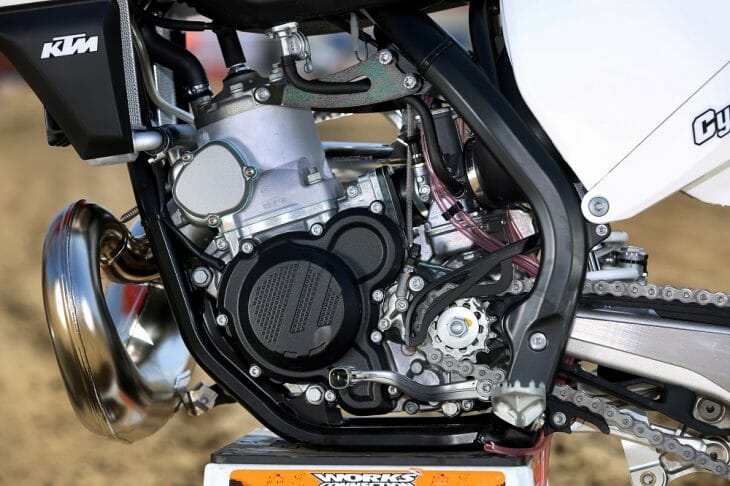 Everything about the motor is new, including a Mikuni carburetor, a trick cylinder-head mount and a counter-balancer.
Everything about the motor is new, including a Mikuni carburetor, a trick cylinder-head mount and a counter-balancer.
Pin It To Win It
KTM set out to create a two-stroke engine that felt more like a four-stroke in both power delivery and vibration. They did an amazing job. The 2017 KTM 250 SX is pure fun to ride. It rolls on smoothly and pulls through a meaty mid into a decent top end. Over-rev isn’t mind blowing but it doesn’t fall on its face when it gets into the highest rpms. While the power is very smooth, it still wants to stand up and lift the front wheel through corners if aggressive with the throttle, it is, after all, still a two-stroke motocross bike. Using third and feathering the clutch rewards the rider who doesn’t want the explosiveness a two-stroke can provide. The great attribute of the engine is that it can be enjoyed by all skill levels. Aggressive riders who want a lot of snap can still ride and enjoy it while riders who were turned off or intimidated by the hit of a two-stroke no longer have to worry about it unexpectedly wanting to launch them off the back.
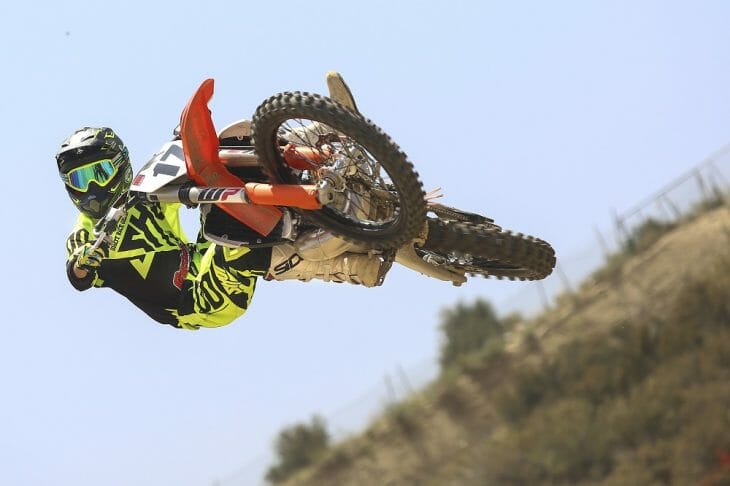 The ultra light and maneuverable KTM 250 SX two-stroke has its advantages on the track.
The ultra light and maneuverable KTM 250 SX two-stroke has its advantages on the track.
Even our older senior vet riders who love their 450 four-strokes felt comfortable with the 250 SX power delivery. It doesn’t explode into the powerful mid; it pulls predictably throughout the rpm range. Our younger pro riders pulled in with a smile after each moto, loving the strong engine and flickable chassis. We experimented with the power valve and half-turn adjustments change the power character noticeably, adding to the versatility of the bike. The switch to a Mikuni carb so far is a non-issue. Stock jetting was pretty close around sea level. Of course, depending on altitude, humanity and ride style, jetting changes will be necessary. KTM tells us the Mikuni is less sensitive to atmospheric changes than the Keihin. The new counter-balancer does an excellent job of reducing vibration. After spending a few hours riding this engine, anything without a counter-balancer is going to seem archaic. The bottom line is that the new engine is a big improvement in power delivery and in vibration.
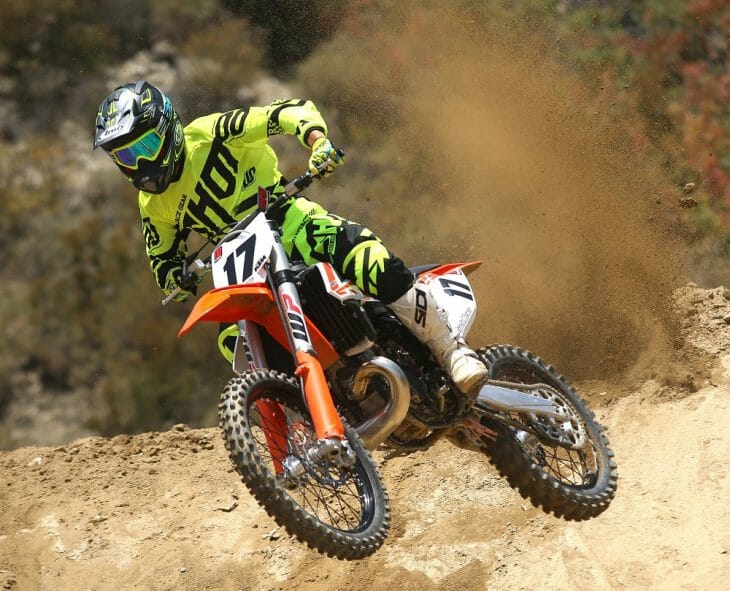 The 250 SX is surprisingly stable, planted and predictable.
The 250 SX is surprisingly stable, planted and predictable.
Planted And Stable
A common characteristic of two-strokes is that they are busy and nervous. Typically a two-stroke motocross bike doesn’t feel nearly as planted as a four-stroke. The 2017 KTM 250 SX rewrites those stereotypes. It is surprisingly stable, planted and predictable. We jumped back and fourth between the 250 SX and four-strokes, finding the KTM 250 SX was just as planted and stable. A pleasant surprise.
Turning is a strong trait but it is also very dependent on the rider’s use of power. Smooth throttle and clean clutch work keeps the bike laid over in ruts and overall the 250 SX turns effortlessly in all types of corners. It will want to stand up in ruts if erratic and impatient with the throttle, a common trait for two-strokes. Turning technique has to be adjusted when coming from a four-stroke to take full advantage of what the 250 SX has to offer. Diving into corners and slowing the 250 SX is ultra easy thanks to its weight—only 212 pounds without fuel. The rear-brake pedal is now 10mm longer and the brake-pad material is less aggressive for more modulation, which takes a few laps to get accustomed to but it is a nice improvement, reducing the tendency to spike the rear brake.
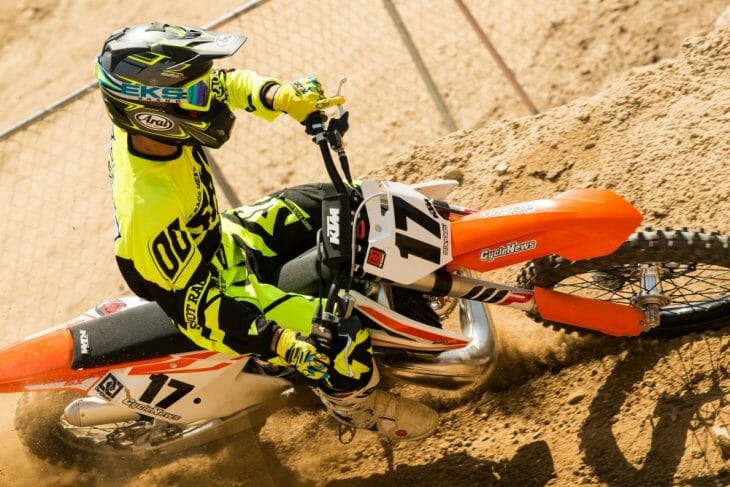 Fueled up, the 250 SX weighs 212 pounds, which makes it easy to dive it in a corner or slow it down.
Fueled up, the 250 SX weighs 212 pounds, which makes it easy to dive it in a corner or slow it down.
We stayed with 105mm of sag and used the recommended 149 psi in the WP AER 48 air fork. Stock compression setting on the fork is 12; we hovered around 10 depending on the track and bigger riders added a few psi. WP did an amazing job with the AER 48 air fork, it out-performs all other air forks and rivals some good spring forks, plus it is 3.6 pounds lighter than the WP 4CS fork it replaces. Bottoming resistance from the AER 48 is excellent while still providing great bump compliance and a planted front-wheel feel. The shock does a good job of staying planted to the ground both under braking and acceleration. Again, the smooth delivery from the new engine really helps keep the rear wheel planted to the ground.
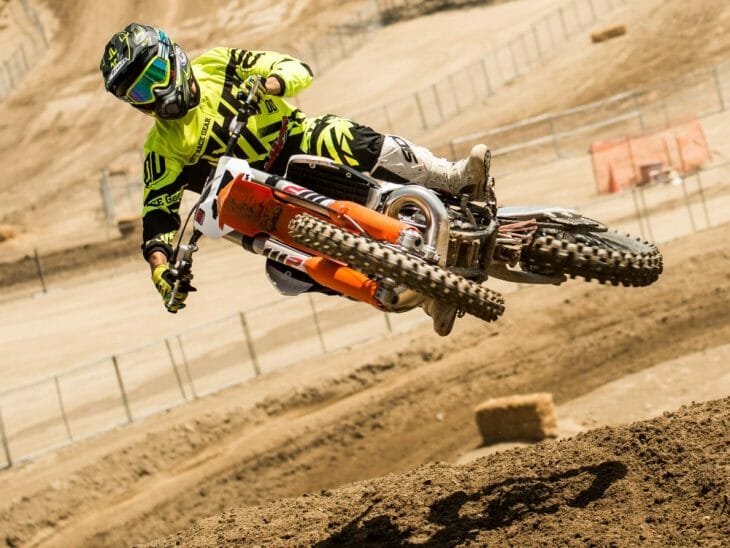 The 250 SX is fitted with what we feel is the best production air fork out there—the WP AER 48.
The 250 SX is fitted with what we feel is the best production air fork out there—the WP AER 48.
You Want One!
The all-new KTM 250 SX is a wicked two-stroke motocross machine. It is also a blast to ride and embraces everything two-strokes are about. It is light, fast and simple. KTM has created a powerful, yet smooth engine in a chassis that is stable and predictable with good suspension. We love it! See for yourself in the following video:
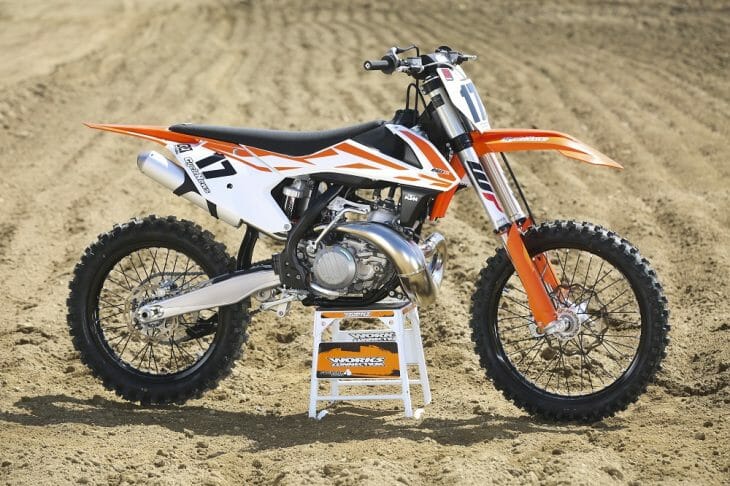
2017 KTM 250 SX SPECIFICATIONS:
|
|
Engine:
|
Single cylinder, liquid-cooled, 2-stroke
|
|
Displacement:
|
249cc
|
|
Bore x Stroke:
|
66.4 x 72mm
|
|
Compression ratio:
|
N/A
|
|
Fuel System:
|
Mikuni TX 38 carburetor
|
|
Lubrication:
|
Premix 60:1
|
|
Clutch:
|
Wet multi-disc DDS-clutch, Brembo hydraulics
|
|
Transmission:
|
5-speed
|
|
Final Drive:
|
13/48
|
|
Frame:
|
Chromoly steel
|
|
Front suspension:
|
WP suspension AER 48 USD 48mm, 11.8 inches travel
|
|
Rear suspension:
|
WP monoshock 5018 BAVP DCC with linkage, 11.8 inches travel
|
|
Front brake:
|
Brembo 260mm disc
|
|
Rear brake:
|
Brembo 240mm disc
|
|
Front tire:
|
21-in. Dunlop MX3S
|
|
Rear tire:
|
19-in. Dunlop MX3S
|
|
Rake:
|
26.1°
|
|
Seat height:
|
37.8 in
|
|
Wheelbase:
|
58.5 ± 0.4 in
|
|
Ground clearance:
|
14.6 in
|
|
Weight (without fuel):
|
212 lbs.
|
|
Fuel capacity:
|
1.85 gal.
|
|
MSRP:
|
$7,699
|
For more Cycle News Off-Road motorcycle reviews, click HERE.
For more Cycle News KTM motorcycle reviews, click HERE.